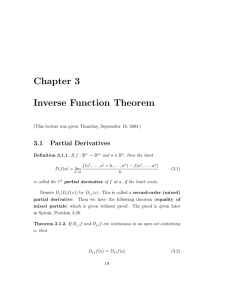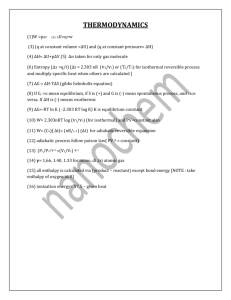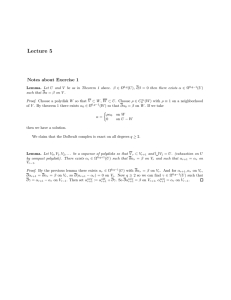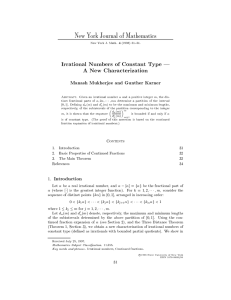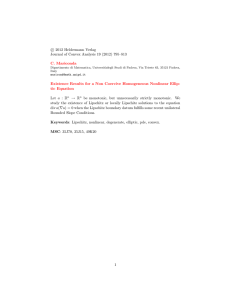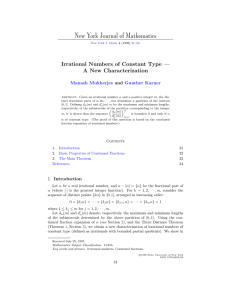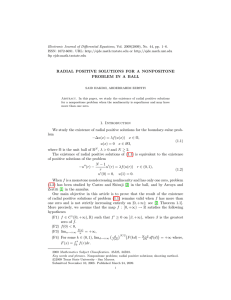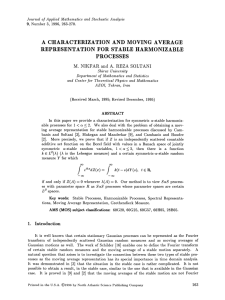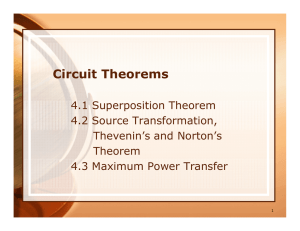ABOUT THE H - MEASURE OF A SET. II. Alina B˘ arbulescu
advertisement
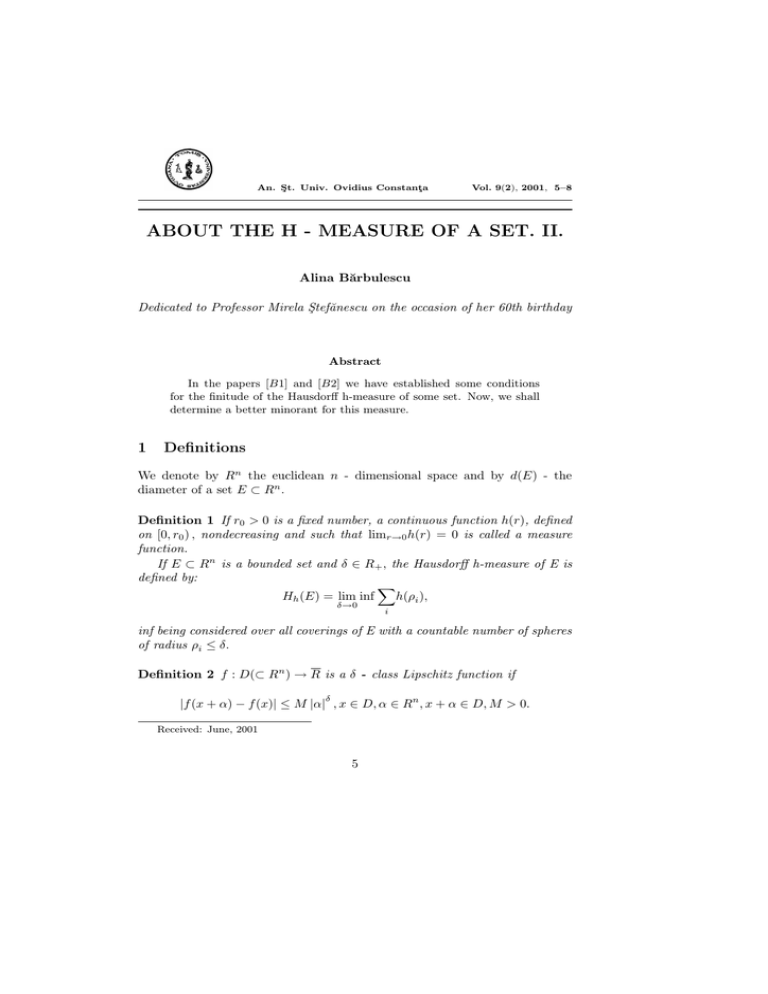
An. Şt. Univ. Ovidius Constanţa
Vol. 9(2), 2001, 5–8
ABOUT THE H - MEASURE OF A SET. II.
Alina Bărbulescu
Dedicated to Professor Mirela Ştefănescu on the occasion of her 60th birthday
Abstract
In the papers [B1] and [B2] we have established some conditions
for the finitude of the Hausdorff h-measure of some set. Now, we shall
determine a better minorant for this measure.
1
Definitions
We denote by Rn the euclidean n - dimensional space and by d(E) - the
diameter of a set E ⊂ Rn .
Definition 1 If r0 > 0 is a fixed number, a continuous function h(r), defined
on [0, r0 ) , nondecreasing and such that limr→0 h(r) = 0 is called a measure
function.
If E ⊂ Rn is a bounded set and δ ∈ R+ , the Hausdorff h-measure of E is
defined by:
X
Hh (E) = lim inf
h(ρi ),
δ→0
i
inf being considered over all coverings of E with a countable number of spheres
of radius ρi ≤ δ.
Definition 2 f : D(⊂ Rn ) → R is a δ - class Lipschitz function if
δ
|f (x + α) − f (x)| ≤ M |α| , x ∈ D, α ∈ Rn , x + α ∈ D, M > 0.
Received: June, 2001
5
6
A. Bărbulescu
Definition 3 Let ϕ1 , ϕ2 > 0 be functions defined in a neighborhood of 0 ∈ R n .
We say that ϕ1 and ϕ2 are equivalent and we denote by: ϕ1 ∼ ϕ2 , for x → 0,
if there exist r > 0, Q > 0, satisfying:
1
ϕ (x) ≤ ϕ2 (x) ≤ Qϕ1 (x), (∀)x ∈ Rn , |x| < r.
Q 1
An analogous definition can be given for x → ∞. In this case, ϕ1 ∼ ϕ2 means
that the previous inequalities have place in all the space.
If f : [0, 1] −→ R, the graph of f is the set: Γ = {(x, f (x))|x ∈ [0, 1]} .
2
Results
Theorem 1 If δ ∈ [0, 1] , h is a measure function such that
h(t)˜t2
(1)
and f : [0, 1] → R is a δ- class Lipschitz function, then: Hh (Γ) < +∞.
(see [B1])
Lemma 2 Consider that E ⊂ Rn is a closed and bounded set, which has a
finite Hausdorff h - measure. Suppose that there exists an additive function
ϕ(U ),defined on union, U , of n - dimensional intervals of the type
Q = [a1 , b1 ) × ... × [an , bn ) , ai , bi ∈ R, ai < bi , i = 1, 2, ..., n,
(2)
and which satisfies the properties:
(1) ϕ(U ) ≥ 0, for every U;
(2) if U ⊇ E then ϕ(U ) ≥ α, where α is a fixed constant;
(3) there exists a constant k 6= 0 such that:
ϕ(U ) ≤ k · h [d(U )] .
Then:
Hh (E) ≥
(3)
α
.
k
Proof. We denote by M the set of all intervals U of the type (2). To
determine Hh (E), we consider a covering of E with sets that satisfy Definition
1. From the Heine - Borel - Lebesgue theorem, it results that we can choose
a finite number of convex sets (Ei )i∈I (I is finite) such that: E ⊂ ∪i∈I Ei .
Consider Ei ⊂ Ui ∈M, with:
h [d(Ui )] < (1 + ε)h [d(Ei )] , ε > 0.
7
About the H-measure of a set. II.
From (3), we have:
h [d(Ui )] ≥
1
ϕ(Ui ).
k
Thus:
X
h [d(Ei )] >
X
1
1
1 X
ϕ(∪i∈I Ui )
h [d(Ui )] ≥
ϕ(Ui ) ≥
1+ε
k(1 + ε)
k(1 + ε)
i∈I
i∈I
i∈I
because
ϕ(∪i∈I Ui ) ≤
X
ϕ(Ui ).
i∈I
But ∪i∈I Ui ⊃ E and we can apply (3): there exists a constant α > 0 such
that:
ϕ(∪i∈I Ui ) ≥ α.
Thus
X
i∈I
and Hh (E) ≥
h [d(Ei )] ≥
α
1
ϕ(∪i∈I Ui ) ≥
k(1 + ε)
k(1 + ε)
α
.
k
Theorem 3 In the hypothesis of the previous theorem there exist α, k > 0
α
such that: Hh (Γ) ≥
.
k
Proof. We prove that the conditions ofS
the Lemma 5 are satisfied. Hh (Γ) >
m
0, from the Theorem 4. We consider U = i=1 Qi ,where
Qi = [ai , bi ) × [ci , di ) , ai , bi ∈ R, ai < bi , ci < di , i = 1, 2, ..., m
(4)
and we define
ϕ(U ) =
m
X
i=1;ci di >0
(bi − ai ) × max {|ci | , |di |} +
m
X
(bi − ai ) × |di − ci | . (5)
i=1;ci di >0
(i) ϕ(U ) ≥ 0, for every U.
(ii) We denote:
G1 =
(x, y) ∈ R2 : 0 ≤ x ≤ 1, 0 ≤ y ≤ f (x)
G2 =
(x, y) ∈ R2 : 0 ≤ x ≤ 1, f (x) ≤ y ≤ 0
8
A. Bărbulescu
and α− the sum of the areas of G1 and G2 :
α = σ(G1 ) + σ(G2 ).
If U ⊇ Γ, then ϕ(U ) ≥ α.
(iii) From (1), we deduce that there exists a constant Q > 0 such that:
1 2
d (U ) ≤ h [d(U )] ≤ Qd2 (U ).
Q
Then
ϕ(U ) ≤
m
X
d(U )2 = m · d(U )2 ≤ mQh [d(U )] .
i=1
Using theorem 4, it results:
Hh (Γ) ≥
1
[σ(G1 ) + σ(G2 )] .
mQ
The proof is complete.
References
[B1] A. Barbulescu, La finitude d’une h -mesure Hausdorff d’ une ensemble des points dans
le plan, Analele Univ. ”Valahia”, Târgoviste, 1995/1996, fasc. II, p.93 -99
[B2] A. Barbulescu, About the h - measure of a set, Proceedings of ”International Conference on Complex Analysis and Related Topics”, Brasov, 2001 (to appear)
[B3] A. Barbulescu, P- modulus and p - capacity (PhD. Thesis), Iassy, 1997
”Ovidius” University of Constanta,
Department of Mathematics,
8700 Constanta,
Romania
e-mail: abarbulescu@univ-ovidius.ro
